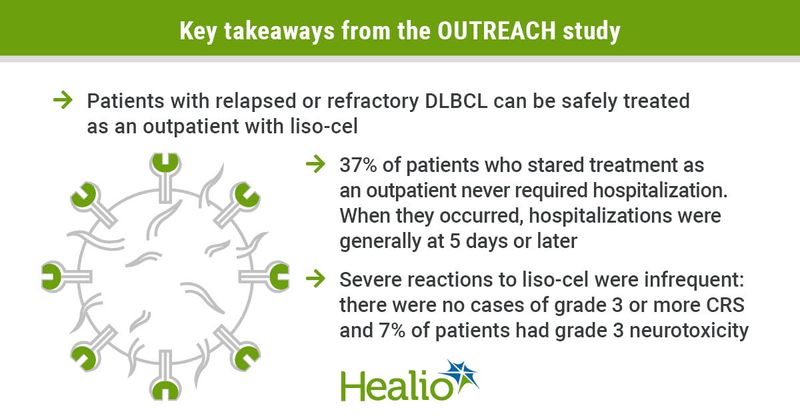Outpatient CAR T-cell therapy safe, effective for advanced large B-cell lymphoma
Click Here to Manage Email Alerts
Patients with relapsed or refractory large B-cell lymphoma who received lisocabtagene maraleucel had similar response rates regardless of the type of center providing the chimeric antigen receptor T-cell therapy, according to study results.
The findings, presented at TCT Meetings Digital Experience, also showed no additional safety risks associated with outpatient vs. inpatient administration of the CAR T-cell therapy at nonacademic medical centers.

“Patients with relapsed [large B-cell] lymphoma can be safely treated as an outpatient with this CAR-T product,” John E. Godwin, MD, MS, program leader for hematologic malignancies at Providence Cancer Center’s Earle A. Chiles Research Institute, told Healio.
More than one-third (37%) of patients in the study did not require hospitalization after infusion of CAR T cells, he said.
“This study demonstrates that CAR-T can be administered outside the university setting,” Godwin said, adding that to do so requires a multidisciplinary team and a hospital affiliation or partnership.
The open-label, multicenter, phase 2 OUTREACH trial evaluated the safety and efficacy of lisocabtagene maraleucel (Breyanzi, Bristol Myers Squibb) — a CD19-directed, genetically modified, autologous CAR T-cell therapy — in the outpatient and inpatient settings for patients with relapsed or refractory large B-cell lymphoma.
Lisocabtagene maraleucel — also known as liso-cel — received FDA accelerated approval Feb. 5 for adults with relapsed or refractory diffuse large B-cell lymphoma who received two or more lines of systemic therapy.
Participating sites in the OUTREACH trial included nonuniversity specialty oncology centers with hematopoietic stem cell transplant or phase 1 clinical trial capabilities. Study protocol also required qualifying facilities to have an outpatient infusion center, an affiliated leukapheresis center and a multidisciplinary medical care team that included an oncologist on call at all times.
Godwin and colleagues presented preliminary efficacy and safety results of 46 patients (median age, 63 years; range, 34-83; 67% men) who received liso-cel as of data cutoff, including 30 (median age, 63 years, range 35-83; 70% men) treated as outpatients and 16 (median age, 64.5 years; range, 34-81; 62.5% men) treated as inpatients.
Baseline characteristics of patients in the OUTREACH study were comparable to those of participants in the TRANSCEND-NHL-001 trial, the pivotal study that led to FDA approval of liso-cel.
Patients in OUTREACH had a median two (range, 2-6) previous lines of therapy, and 20% of had undergone HSCT.
Patients received lymphodepleting chemotherapy with 300 mg/m2 cyclophosphamide and 30 mg/m2 fludarabine daily for 3 days, followed by an infusion of liso-cel at a dose of 100 × 106 CAR T cells.
Treatment-related adverse events served as the study’s primary endpoint, including the proportion of patients experiencing cytokine release syndrome, neurotoxicity, prolonged cytopenias and grade 3 or higher infections. Secondary endpoints included safety and objective response rates.
Median follow-up was 6.67 months (range, 0.4-16) for the overall cohort and subgroup of outpatients, and 6.85 months (range, 2.2-13.9) for inpatients.
Results showed 41% of patients developed CRS, including 43% of outpatients and 37.5% of inpatients. No cases of grade 3 or greater CRS occurred.
Median time to onset of CRS was 4 days (range, 1-9) for the entire study population but was twice as long for outpatients as inpatients (5 vs. 2.5 days).
Outpatients and inpatients had similar rates of neurotoxicity (30% vs. 31%). Two outpatients and one inpatient experienced grade 3 or higher neurotoxicity.
Median time to onset of neurotoxicity was similar for both outpatients and inpatients (9 days vs. 10 days).
Six patients, including five treated as outpatients, developed grade 3 or worse infection after CAR T-cell therapy; 30% of outpatients vs. 12.5% of inpatients had prolonged grade 3 or worse cytopenias.
Nineteen outpatients (63%) required hospitalization following treatment, including eight on day 4 or earlier after infusion. Fifty-three percent of outpatients were hospitalized due to treatment-related adverse events, and one outpatient required ICU admission after infusion.
Median length of hospital stay was 6 days (range, 1-28), with median time to hospitalization of 5 days (range, 2-61).
Researchers reported ORRs of 77% for all evaluable patients, 79% for outpatients and 75% for inpatients. Outpatients had a higher rate of complete response than inpatients (61% vs 50%).
Eleven of 12 patients (92%) with 6 months or more of follow-up had an ongoing complete response to therapy as of the data cutoff point.
It is difficult to predict which patients will require hospitalization after CAR T-cell therapy, but that the results suggest outpatient administration is feasible with the proper approach, Godwin said.
“This study indicates that CAR T-[cell] therapy can be delivered to patients who may not be in a major city, as long as a cancer program can partner with a hospital to coordinate care,” he added.

